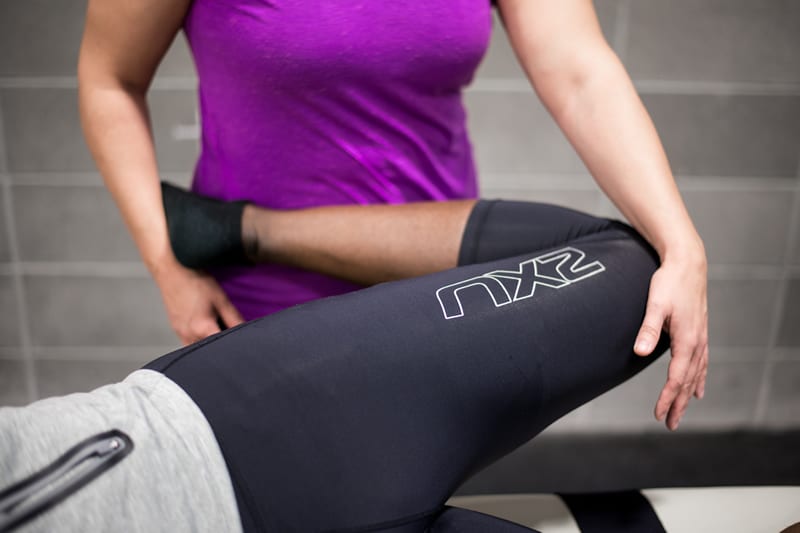Stretching has become a hot topic in the world of fitness. Common statements I hear are, “I should stretch more but it’s too boring”, “Stretching really hurts”, or, “I’m confused about stretching”. These remarks set off red flags for me, but I do understand where these individuals are coming from. I too was confused about stretching and while I was in school studying massage therapy, I had so many unanswered questions. I did my own research and came across a book called “Stretch to Win” by Ann and Chris Frederick and came across Fascial Stretch Therapy ™.
Let me begin by explaining fascia. Up until recently it has perhaps been misunderstood. A leading expert in the field, Thomas Myers, describes fascia as the biological fabric that holds us together. It is all the collagenous based soft tissues in the body. This includes tendons, ligaments, bursae, and all the fascia around the muscle; endomysium, perimysium, epimysium. It also includes fascia around organs, and membranes around the brain, spinal cord, and peripheral nerves. This neuromyofascial web responds systemically as well as locally. (anatomytrains.com)
This definition changes our perception to think of the human body as a tensegrity model. Push somewhere along the model (stress to the body) and that deformation is distributed throughout. So, with fascia being a complex communication network constantly transmitting and receiving signals, you can see why I had so many unanswered questions about stretching. If we are not linear, why do we stretch like robots?
Fascial Stretch Therapy, or FST™ was created by Ann and Chris Frederick and is a form of manual therapy that incorporates 10 fundamental principles which sets it apart from other stretch therapies and fascial treatments. Along with assisted stretches using their StretchWave™, it incorporates specific joint mobilization techniques to allow for a better stretch response and restoration to one’s joint range of motion. It redefines stretching with diagonal, and rotational movement patterns, instead of the standard linear style of stretching. In short, stretch how one is designed to move. Because of these movements and because the entire joint is targeted, fluid motion post treatment is noted. It follows the principle of stretching fascia not just muscle. It is a painless treatment, as the therapist works with the client’s stretch tolerance, adjusting frequency, intensity, and duration of stretches. A session can last anywhere from 30 to 90 minutes depending on the client’s need and current goals. There is more scientific explanation behind FST which I would love to explain in depth, but for the sake of this article I will simply say, “It’s like assisted stretching took a pre-workout drink.”
As a therapist, I treat common dysfunctions using FST along with massage therapy or as its own treatment. I have seen great success treating low back pain, treating clients post-surgery (where indicated) and treating athletes therapeutically as well as prepping them for competition.
Recently I’ve had the honor to work with 2 time Olympic bobsledder, Neville Wright to see how and if it impacted his training in a positive way. His sport requires an abundance of speed and power that all comes down to fractions of a second when crossing the finish line. There is no room for error and definitely no room for myoskeletal imbalances.
Prior to FST treatments, Neville was noticing some issues during sprinting that were impacting his times. During treatments it was discovered his left shoulder was restricted and this was limiting his power output from his hips. After 3 sessions, there were improvements in his times along with more agility while sprinting and jumping. The body takes on a lot of stress during training and over time the joints can compress to help stabilize so it can keep up with the demands we place on it. Because of the decompressive nature of FST, Neville has described that he feels lighter through the shoulders, hips and torso with increased range of motion and less restriction which helps his sprints, jumps and pushes. At the time of this article we are working on our 7th session and his recovery has never been better.
Here is what Neville had to say about our treatment sessions.
Y: Before FST treatments how important was stretching to your recovery?
N: I feel stretching is a fairly important component to my recovery and maintenance of my mobility, especially after a high intensity training session.
Y: Describe the changes you noticed after your FST sessions.
N: I noticed quite a dramatic increase in mobility and range. There was a great decrease in restriction in some of my major problematic areas such as hips and shoulder.
Y: How has FST impacted your training?
N: It has decreased restrictions in my shoulder, hip and torso; therefore, allowing more range and fluidity in my movements while sprinting and lifting.
Y: Do you see FST incorporated in your recovery regime? And would you recommend it to other athletes?
N: I definitely would incorporate this into my recovery regime and feel that all athletes should incorporate this as a supplemental modality into their programs.
Injuries are a risk athletes are faced with frequently. FST is innovative in its approach to stretching and to treating the body as a whole. It’s a great tool for athletes to incorporate in recovery, training and during events. Adding it to your routine can help mitigate injuries resulting in a greater training season and competitive performance. It has the potential to unlock more speed and power with added positive side effects which can be the difference between 1st and 2nd place.
Yvonne Sanche is a registered massage therapist and a level 2 Fascial Stretch Therapist.








